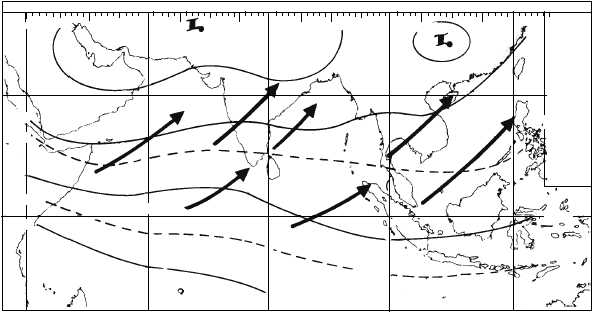and low pressure over the Equatorial Belt sets up a
pressure gradient directed from north to south. Because
of the flow around the massive Siberian high, northeast
winds begin to dominate the regions from India to the
Philippines. (See fig. 3-23).
During the winter months, clear skies predominate
over most of the region. This is caused by the mass
motion of air from a high-pressure area over land to an
area of lower pressure over the ocean. As the air leaves
the high-pressure area over land, it is cold and dry. As it
travels over land toward the ocean, there is no source of
moisture to induce precipitation. The air is also
traveling from a higher altitude to a lower altitude;
consequently, this downslope motion causes the air to
be warmed at the adiabatic lapse rate. This warming
process has a still further clearing effect on the skies.
During the summer the airflow over the region is
completely reversed. The large interior of Asia is
heated to the point where the continent is much warmer
than the ocean areas to the south. This induces
relatively low pressure over Asia and higher pressure
over the equatorial region. This situation produces a
southwesterly flow as shown in figure 3-24.
3-21
COLD SIBERIAN
HIGH
EQUATOR
1014
1024
1024
1020-
1018
1016
1014
10
10
1012
1012
1018
AG5f0323
40O
O
O
O
O
O
O
O
O
50
60
70
80
90
100
110
120
WARM
OCEAN
SURFACE
Figure 3-23.—Northeast monsoon (January).
AG5f0324
40O
O
O
O
O
O
O
O
O
50
60
70
80
90
100
110
120
HOT INTERIOR
COOLER OCEAN
SURFACE
1008
1012
1010
1000
1004
99
98
1000
1004
1006
1010
1012
EQUATOR
1008
1006
1000
Figure 3-24.—Southwest monsoon (July).




